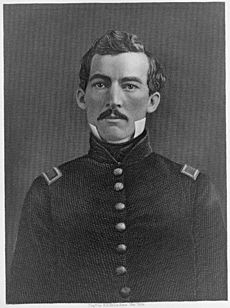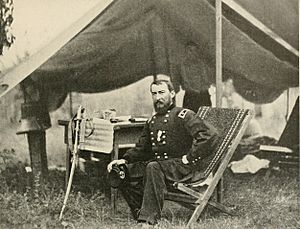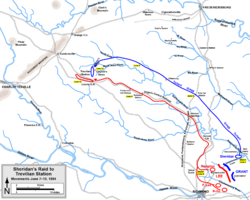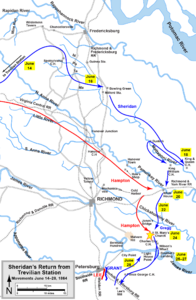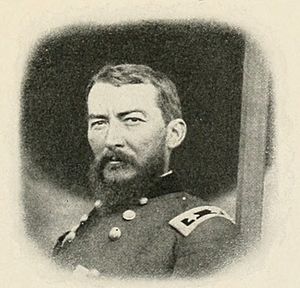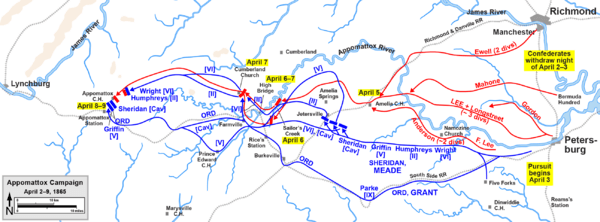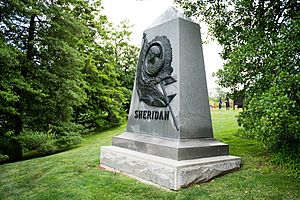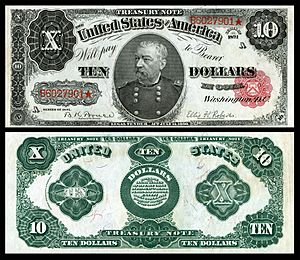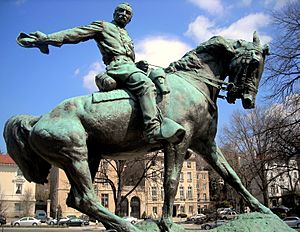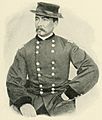Philip Sheridan facts for kids
Quick facts for kids
Philip Sheridan
|
|
|---|---|
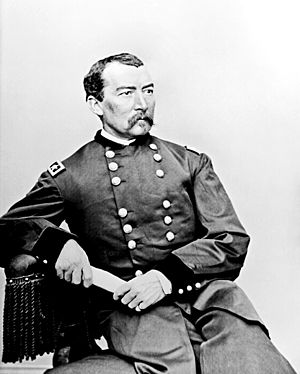
Sheridan during the 1860s
|
|
| Birth name | Philip Henry Sheridan |
| Nickname(s) | "Little Phil" "Fightin' Phil" |
| Born | March 6, 1831 Albany, New York, U.S. |
| Died | August 5, 1888 (aged 57) Nonquitt, Massachusetts, U.S. |
| Buried | |
| Allegiance | United States (Union) |
| Service/ |
U.S. Army (Union Army) |
| Years of service | 1853–1888 |
| Rank | General of the Army |
| Commands held | Cavalry Corps Army of the Shenandoah Middle Military Division Department of the Missouri |
| Battles/wars | |
| Alma mater | United States Military Academy |
| Signature | |
General of the Army Philip Henry Sheridan (March 6, 1831 – August 5, 1888) was a high-ranking officer in the United States Army. He became a Union general during the American Civil War. He quickly rose through the ranks, becoming a major general. He worked closely with General-in-chief Ulysses S. Grant.
In 1864, Sheridan led Union forces to victory against Confederate General Jubal Early in the Shenandoah Valley. He also destroyed farms and supplies in the Valley. This was one of the first times "scorched-earth" tactics were used in the war. In 1865, his cavalry helped force Confederate General Robert E. Lee to surrender. After the Civil War, Sheridan fought in the Indian Wars on the Great Plains. He also played a key role in creating and protecting Yellowstone National Park. In 1883, he became the general-in-chief of the U.S. Army. He was promoted to General of the Army in 1888.
Contents
Philip Sheridan's Early Life and Education
Philip Sheridan was born in Albany, New York. He was the third of six children. His parents, John and Mary Sheridan, were Irish Catholic immigrants. He grew up in Somerset, Ohio. Sheridan was quite short, only 5 feet 5 inches (165 cm) tall. This earned him the nickname "Little Phil."
As a boy, Sheridan worked in a general store. Later, he was a clerk and bookkeeper at a dry goods store. In 1848, he got a spot at the United States Military Academy (West Point). During his fourth year, he was suspended for a year after a fight with a classmate. He graduated in 1853, ranking 34th in his class of 52 cadets.
After graduating, Sheridan became a brevet second lieutenant. He served in Texas and California. Most of his early service was in the Pacific Northwest. He gained experience leading small combat teams during the Yakima War and Rogue River Wars. He was even wounded once when a bullet grazed his nose. He also learned diplomatic skills while working with Native American tribes. He was promoted to first lieutenant in March 1861, just before the Civil War. He became a captain in May, weeks after the attack on Fort Sumter.
Sheridan's Role in the Civil War
Fighting in the Western Theater
In 1861, Sheridan was sent to Jefferson Barracks in Missouri. He was asked to check the financial records of a previous general. Sheridan did a great job, which impressed his superiors. He was then appointed chief officer for supplies for the Army of Southwest Missouri.
Sheridan served under Maj. Gen. Samuel Ryan Curtis at the Battle of Pea Ridge. He found that some officers were stealing horses and demanding payment. Sheridan refused to pay for stolen property. He confiscated the horses for the army's use. This led to him being arrested for insubordination, but the charges were dropped.
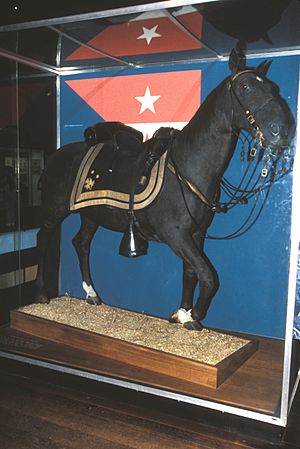
In May 1862, Sheridan became a colonel of the 2nd Michigan Cavalry. He had no previous experience with cavalry. A month later, he led his first forces in battle at Battle of Booneville, Mississippi. His actions impressed his commanders, who recommended him for promotion. He was promoted to brigadier general in September, effective July 1. Around this time, he received the horse he named Rienzi, which he rode throughout the war.
Sheridan led his division at the Battle of Perryville in October 1862. His aggressive actions helped push back Confederate forces. On December 31, 1862, at the Battle of Stones River, Sheridan prepared for a Confederate attack. His division held their ground until they ran out of ammunition. This gave the Union army time to regroup. For his bravery, he was promoted to major general in April 1863. In just six months, he had risen from captain to major general.
Sheridan's division also fought in the Tullahoma Campaign. They were the first to enter the town of Tullahoma. At the Battle of Chickamauga in September 1863, his division was overwhelmed. But he gathered his men and tried to return to the fight. This showed his commitment, unlike some other generals who retreated.
During the Battle of Chattanooga in November 1863, Sheridan's division charged up Missionary Ridge. They broke through Confederate lines, going beyond their orders. Sheridan's quick actions helped capture many prisoners and artillery. General Grant praised Sheridan's pursuit, saying it led to many captures.
Leading the Overland Campaign
In 1864, General Ulysses S. Grant became the general-in-chief of all Union armies. He called Sheridan to the East to lead the Cavalry Corps of the Army of the Potomac. Sheridan arrived on April 5, 1864, just before Grant's major Overland Campaign against Robert E. Lee.
In early battles like the Battle of the Wilderness, Sheridan's cavalry was mostly used for scouting. This frustrated Sheridan. When his commander, Maj. Gen. George Meade, criticized him, Sheridan said he could "whip Stuart" (Confederate cavalry commander J.E.B. Stuart) if given the chance. Grant told Meade to let Sheridan try.
- Sheridan in the Overland Campaign
-
Sheridan's Richmond Raid, including the Battles of Yellow Tavern and Meadow Bridge
-
Routes of Federal and Confederate cavalry to Trevilian Station, June 7–10, 1864
-
Sheridan's return to the Army of the Potomac from his Trevilian Station raid, including the Battle of Saint Mary's Church
From May 9 to May 24, Sheridan led a raid towards Richmond. During this raid, he mortally wounded Confederate cavalry commander Maj. Gen. J.E.B. Stuart at Battle of Yellow Tavern on May 11. This was a major Union victory. However, the raid did not seriously threaten Richmond.
Sheridan's cavalry also fought at Battle of Haw's Shop and helped secure the crossroads for the Battle of Cold Harbor. He then led another raid to break the Virginia Central Railroad. He was stopped by Confederate cavalry at the Battle of Trevilian Station. This was the largest all-cavalry battle of the war. Sheridan withdrew without completing his mission.
Historians have different opinions on Sheridan's success in the Overland Campaign. While the death of Jeb Stuart at Yellow Tavern was a clear Union victory, other battles were less successful for Sheridan.
Commanding the Army of the Shenandoah
Throughout the war, Confederate armies used the Shenandoah Valley to invade the North. In 1864, Lt. Gen. Jubal Early used this route to threaten Washington, D.C.. Grant put Sheridan in charge of the Middle Military Division. His job was to defeat Early's army and stop the Confederates from using the Valley for food and supplies. Grant told Sheridan to destroy railroads and crops. He wanted to make the Valley a "barren waste."
Sheridan took command on August 7, 1864. After a month of preparation, he launched his attacks. On September 19, Sheridan defeated Early's army at Third Winchester. He followed this with another victory at Battle of Fisher's Hill on September 22.
After these victories, Sheridan began destroying the Valley's resources. His men seized livestock, provisions, and burned barns, mills, and railroads. This destruction made over 400 square miles uninhabitable. Residents called this "The Burning." This tactic was similar to Sherman's March to the Sea in Georgia.
On October 19, Early launched a surprise attack at Battle of Cedar Creek. Sheridan was ten miles away in Winchester. Hearing the battle, he rode quickly to his army. He arrived and rallied his men, turning what looked like a defeat into a victory. Early's army was severely weakened. President Abraham Lincoln thanked Sheridan and promoted him to major general in the regular army. A famous poem, Sheridan's Ride, was written about his return to the battle. Sheridan even renamed his horse, Rienzi, to "Winchester" because of the poem.
The Appomattox Campaign
In March 1865, Sheridan decided to rejoin the Army of the Potomac near Petersburg. He wanted his cavalry to be there for the end of the war. His actions during the Appomattox Campaign were crucial.
On March 2, at the Battle of Waynesboro, he trapped the rest of Early's army. Over 1,500 Confederate soldiers surrendered. On April 1, at Battle of Five Forks, he cut off General Lee's supply lines. This forced Lee to leave Petersburg.
Sheridan's aggressive actions at the Battle of Sayler's Creek on April 6 captured over 20% of Lee's remaining army. President Lincoln sent Grant a telegram saying, "Gen. Sheridan says 'If the thing is pressed I think that Lee will surrender.' Let the thing be pressed." At Battle of Appomattox Court House, on April 9, 1865, Sheridan blocked Lee's escape. This forced the surrender of the Army of Northern Virginia. Grant praised Sheridan, saying he had "no superior as a general."

After the Civil War: Reconstruction and Indian Wars
Reconstruction Efforts

After the Civil War, Sheridan was made commander of the Military District of the Southwest. His job was to bring Texas and Louisiana back under Union control. He assembled a large force of 50,000 men. His presence helped convince the French to leave Mexico, where they had supported a ruler named Maximilian. Sheridan later admitted he secretly supplied weapons to Mexican forces fighting against the French.
In March 1867, Sheridan became the military governor of Texas and Louisiana. He limited voting rights for former Confederates. He also said that only registered voters, including black men, could serve on juries. Sheridan removed several local officials and even the governors of Louisiana and Texas. He accused them of being dishonest or hindering Reconstruction. President Andrew Johnson disagreed with Sheridan's actions. Johnson removed Sheridan from his post, calling his rule "absolute tyranny."
Sheridan was not popular in Texas. He once famously joked, "If I owned Texas and Hell, I would rent Texas and live in Hell." This showed his dislike for the state at the time. He was sent back to Louisiana twice more to help keep peace during political problems.
Fighting in the Indian Wars
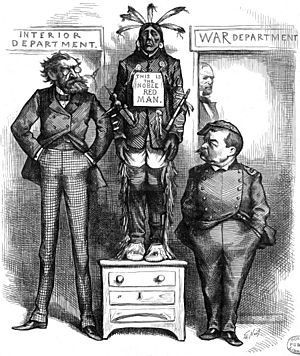
In September 1866, Sheridan was sent to Texas to manage the former Confederate area. He spent three months dealing with Native American raids in the Texas Hill Country.
Later, Sheridan was put in charge of the Department of the Missouri. This huge area covered land between the Mississippi River and the Rocky Mountains. His main goal was to encourage Native American tribes, like the Sioux and Cheyenne, to live on reservations. He used a tough strategy to achieve this.
In the Winter Campaign of 1868–69, Sheridan attacked the Cheyenne, Kiowa, and Comanche tribes in their winter camps. His troops took their supplies and livestock. This forced the tribes back onto their reservations.
When William T. Sherman became General of the Army, Sheridan took command of all the Great Plains. His department fought in the Red River War, the Ute War, and the Great Sioux War of 1876–77. This last war led to the death of Lt. Col. George Armstrong Custer. Native American raids decreased in the 1870s and were mostly over by the early 1880s.
A famous quote, "The only good Indian I ever saw were dead," is often linked to Sheridan. However, he denied ever saying it. Historians believe this quote is likely not true. Sheridan himself said, "We took away their country and their means of support…and against this they made war. Could anyone expect less?" He also believed Congress should provide food for Native Americans on reservations. He saw his duty as protecting the settlers on the frontier.
Later Career and Yellowstone Protection
Sheridan was promoted to lieutenant general on March 4, 1869. In 1870, President Grant sent him to observe the Franco-Prussian War in Europe. He was a guest of King Wilhelm I of Prussia. He saw Emperor Napoléon III surrender to the Germans. Sheridan later criticized the French army for its slow movements and missed opportunities.
In 1871, Sheridan was in Chicago during the Great Chicago Fire. He helped coordinate military relief efforts. The mayor put the city under martial law and put Sheridan in charge for a few days.
On November 1, 1883, Sheridan became the Commanding General of the U.S. Army. He held this position until his death. He was promoted to General (equivalent to a five-star general today) on June 1, 1888, shortly before he died.
Protecting Yellowstone National Park
Protecting the Yellowstone area was very important to Sheridan. He sent military escorts for early expeditions there in 1870 and 1871. Mount Sheridan, a peak in Yellowstone, was named after him in 1871. As early as 1875, Sheridan wanted the military to control the area. He wanted to prevent the destruction of its natural beauty and wildlife.
In 1882, a company planned to build a railroad into the park and sell land. Sheridan strongly opposed this plan. He worked hard to convince Congress to protect the park. He wanted military control and less development. He even arranged a trip to the park for President Chester A. Arthur. His efforts paid off. In 1886, Sheridan ordered the 1st U.S. Cavalry into the park. The military managed Yellowstone until the National Park Service took over in 1916.
Personal Life and Death
On June 3, 1875, Sheridan married Irene Rucker. She was 22, and he was 44. They had four children: Mary, Irene, Louise (twins), and Philip Jr. They lived in Washington, D.C., in a house given to them by the citizens of Chicago.
In 1888, Sheridan suffered several heart attacks. He had just sent his memoirs to the publisher. Congress quickly passed a law to promote him to General of the Army. He died of heart failure on August 5, 1888, at his summer home in Massachusetts.
His body was brought back to Washington. He was buried in Arlington National Cemetery. His grave is on a hillside facing the capital city. His wife, Irene, never remarried. She said she would rather be his widow than marry anyone else.
Honors and Legacy
Philip Sheridan is the only person on a U.S. ten-dollar bill who was only a military figure, not a politician. He appeared on $10 Treasury notes in 1890 and 1891. His image also appeared on a $5 silver certificate in 1896. These notes are very rare today.
Many places are named after him. Fort Sheridan was named to honor his service to Chicago. An equestrian statue of Sheridan stands in Chicago. Sheridan Road in Chicago and its suburbs is also named for him. The M551 Sheridan tank is named after him.
Mount Sheridan in Yellowstone National Park was named for him in 1871. The Sheridan Prize is a yacht-racing trophy on Geneva Lake.
In 1937, the U.S. Post Office issued a stamp honoring Generals Ulysses S. Grant, William T. Sherman, and Philip H. Sheridan.
Several counties and cities across the U.S. are named for Sheridan. These include counties in North Dakota, Nebraska, Montana, Wyoming, and Kansas. Cities like Sheridan, Wyoming and Sheridan, Oregon also bear his name.
Sheridan Square in New York City is named for him, with a statue nearby. Sheridan Circle in Washington, D.C., is also named after him. The only equestrian Civil War statue in Ohio honoring Sheridan is in his hometown of Somerset, Ohio.
Sheridan High School in Ohio is near his childhood home. Their athletic teams are called "The Generals." Sheridan Glacier in Alaska was named in his honor. In Albany, New York, there is an equestrian statue of Sheridan.
During World War II, a U.S. liberty ship, SS Philip H. Sheridan, was named after him. Sheridan Drive in Arlington National Cemetery is near his grave. A statue of Sheridan is in Scranton, Pennsylvania.
John Philip Sousa wrote a musical piece called "Sheridan's Ride" in 1891. It describes Sheridan's famous ride at the Battle of Cedar Creek. Sheridan Hall at Fort Hays State University in Kansas is also named for him.
Sheridan's Military Ranks
| Insignia | Rank | Component | Date |
|---|---|---|---|
| No insignia | Cadet, USMA | Regular Army | July 1, 1848 |
| Brevet Second Lieutenant | Regular Army | July 1, 1853 | |
| Second Lieutenant | Regular Army | November 22, 1854 | |
| First Lieutenant | Regular Army | March 1, 1861 | |
| Captain | Regular Army | May 14, 1861 | |
| Colonel | Volunteers | May 25, 1862 | |
| Brigadier General | Volunteers | July 1, 1862 | |
| Major General | Volunteers | December 31, 1862 | |
| Brigadier General | Regular Army | September 20, 1864 | |
| Major General | Regular Army | November 8, 1864 | |
| Lieutenant General | Regular Army | March 4, 1869 | |
| General of the Army | Regular Army | June 1, 1888 |
Images for kids
See also
 In Spanish: Philip Sheridan para niños
In Spanish: Philip Sheridan para niños
- List of American Civil War generals (Union)


